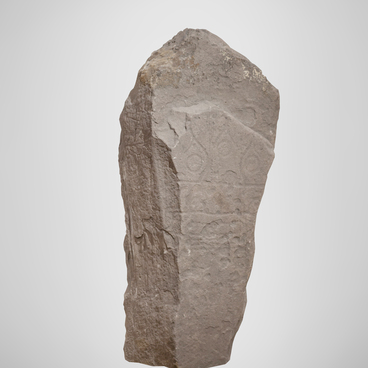On the territory of modern Khakassia there are numerous mounds with stone stelae. Most of them were created in the 8th–2nd centuries BC for burial. Archaeologists call this period the Tagar culture, synchronous with the Scythian culture of the Northern Black Sea region. This time was characterized by the construction of majestic burial mounds with a high earthen embankment and the production of similar bronze items of the so-called Scythian triad — horse equipment for riding, weapons and bronze items depicting animals. One of the characteristic elements of the steppe cultures of Eurasia of the Scythian era are cast bronze cauldrons. Most of them were found in the Khakass-Minusinsk depression.
A distinctive feature of the Khakass mounds of the Scythian era is the presence of a fence and stelae made of massive slabs of sandstone or other rock. Quite often there are different images on them — they are called petroglyphs. Some of the petroglyphs were made during the construction of the burial structure, some — at a later time. A similar slab of Devonian sandstone was discovered in 1975 during excavations near the village of Askiz. It was the wall of the mound fence. On the slab, using the pecking technique, images of at least 13 cauldrons of the Scythian type were made. They have a hemispherical or ellipsoidal body on a high base, and the handles are attached to the top edge. On some cauldrons one or two parallel lines are visible — they imitate the ornament of real bronze cauldrons. The images are very similar to real vessels of that time, which are in the museum’s collection. Today these are the only images of bronze cauldrons belonging to the early period of the Tagar culture. According to researchers, they can date back to the 8th — 7th centuries BC.
Scientists believe that bronze cauldrons are part of the richest Scythian burials. Cauldrons, according to the descriptions of the historian Herodotus, were a rarity that is not always at hand. Probably, so many of their images on the slab indicated the significance and high social status of the person buried in the mound.
A distinctive feature of the Khakass mounds of the Scythian era is the presence of a fence and stelae made of massive slabs of sandstone or other rock. Quite often there are different images on them — they are called petroglyphs. Some of the petroglyphs were made during the construction of the burial structure, some — at a later time. A similar slab of Devonian sandstone was discovered in 1975 during excavations near the village of Askiz. It was the wall of the mound fence. On the slab, using the pecking technique, images of at least 13 cauldrons of the Scythian type were made. They have a hemispherical or ellipsoidal body on a high base, and the handles are attached to the top edge. On some cauldrons one or two parallel lines are visible — they imitate the ornament of real bronze cauldrons. The images are very similar to real vessels of that time, which are in the museum’s collection. Today these are the only images of bronze cauldrons belonging to the early period of the Tagar culture. According to researchers, they can date back to the 8th — 7th centuries BC.
Scientists believe that bronze cauldrons are part of the richest Scythian burials. Cauldrons, according to the descriptions of the historian Herodotus, were a rarity that is not always at hand. Probably, so many of their images on the slab indicated the significance and high social status of the person buried in the mound.



